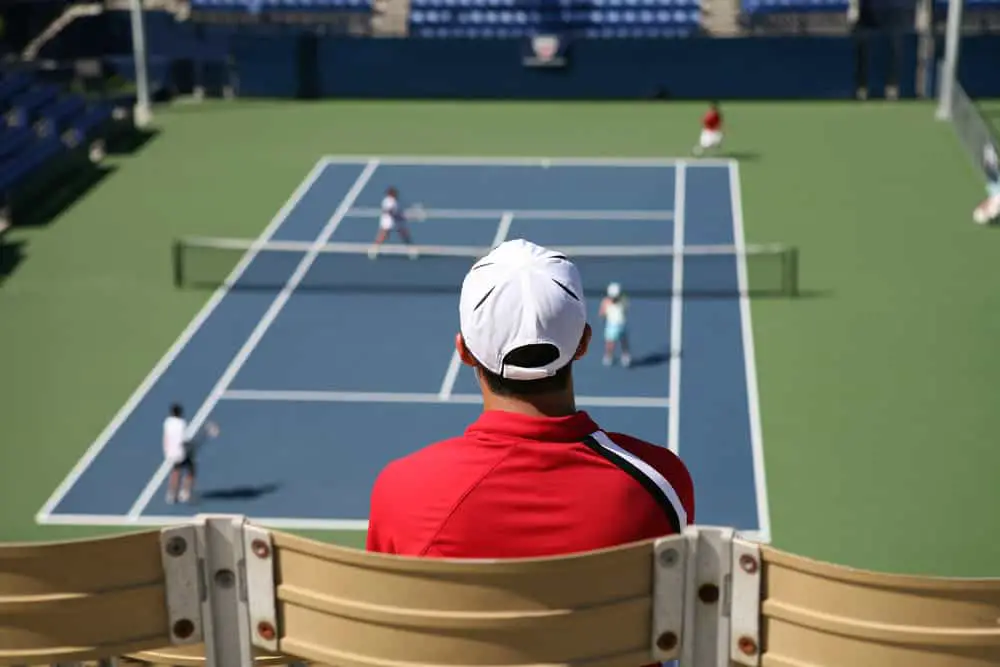History of Tennis – When and Where Was Tennis First Played?
Like wrestling and other sports that have been around for a long time, tennis’ origins have been hotly debated. Usually, a game and its rules are based on other, already-established games. So, finding the true source of the likes of tennis can be difficult.
Key Take Away:
Tennis was first played in 1873 in England, where it was introduced by Major Walter Clopton Wingfield. Officially, this was the first tennis game. However, tennis can also trace its roots to the invention of Jeu de Paume, a 12th-century French game.
Let’s go into more detail about the history of tennis and other aspects like the balls, rackets, and courts.
HEAD's Ti series has long been considered one of the best racquet series for beginners and the Ti S6 tops them all! It's a do-it-all type of racquet at a super affordable price!
But First – Why Trust Me?
I am a seasoned tennis player with over 20 years of experience. I played competitive tennis in High School and am obsessed with anything tennis-related. Understanding the nuances of the game; like when and where tennis was first played will help spread my love for the game.
Who Invented Real Tennis?
Major Walter Clopton Wingfield is often credited with tennis’ invention, although historians have also argued that the sport may have come about earlier. The first sport that likely gave rise to tennis is Jeu de Paume, which originated in France.
Jeu de Paume (literally “palm game”) is a 12th-century game where players hit the ball with their hands instead of a racket (hence the name). One theory by historians suggests that when players hit the ball, they would yell “Tenez!” which is French for “take this.” It’s believed that, over the years, this common term eventually transformed into “tennis.”
As a side note, it may interest you to know that Jeu de Paume also lends its name to an art-turned-photography museum, which (in turn) used to be an arena for French nobles to play the namesake game.
When the French Revolution happened, the revolutionaries also used Jeu de Paume (among other things) to put forward their grievances and eventual overthrow of the aristocracy. Funny how things turn out, huh?

The Birth of Lawn Tennis
The inception of lawn tennis represents a pivotal moment in sports history, blending creativity, innovation, and social mingling into a globally celebrated sport.
During the mid-19th century, Major Harry Gem and Augurio Perera sowed the seeds of this fascinating game in Birmingham, England, by merging elements of racquets and ball sports on a croquet lawn.
Their pioneering spirit led to the establishment of the world’s first tennis club in Leamington Spa. Significantly, Major Walter Clopton Wingfield’s contributions, particularly his promotional strategies, played a crucial role in disseminating the sport.
As lawn tennis gained popularity, it necessitated formal governance, leading to the formation of the National Lawn Tennis Association. This body was instrumental in standardizing rules and fostering the sport’s growth, laying the groundwork for contemporary tennis competitions worldwide.
Tennis History Fun Fact: Do you know one of the rules of tennis that is the most misunderstood?
Origins of Tennis – When Was Modern Tennis Invented?
Modern tennis was invented in 1874 when Major Walter Clopton Wingfield brought tennis to England. His version of the game was dubbed “Sphairistike.” The following year, new rules were added. In 1877, the first Wimbledon tournament was held.
Who Invented the First Tennis Ball?
Charles Goodyear invented the first tennis ball in the 1850s. Originally, Goodyear made the ball completely out of rubber. However, this made the balls wear out quickly, so further changes were necessary. The creation of the tennis ball arguably shaped tennis as it is known today.
As noted, Goodyear originally designed tennis balls to be 100% rubber. However, he found that these couldn’t handle the constant back-and-forth movement tennis required. So, he modified the ball such that the rubber core remained, but the outside was covered to help it last longer. This design is closer to how tennis balls are today.
By covering the ball with fabric and leaving the rubber interior, the ball became lighter and can bounce higher.
Initially, the tennis ball was either black or white. It was usually white as this color best stood out against the color of the tennis courts. In 1972, the official color of the tennis ball was changed to yellow by the International Tennis Federation.
However, the ball remained white until over a decade later, when the yellow ball was finally adopted for Wimbledon tournaments.
Other subtle changes have been made over the years to improve the tennis ball. For example, the weight of the ball varied from 56.7 to 58.5 grams (2 to 2.06 oz) to 56 to 59.4 grams (1.98 to 2.10 oz). There have also been changes to the ball’s diameter (i.e. size), which makes a difference in how well it can bounce while airborne.
When Was the Modern Tennis Racket Invented?
The modern tennis racket was invented in 1874. Made by Major Walter Clopton Wingfield, it was made out of solid wood and could seriously injure players if improperly handled. Over the years, materials for tennis rackets have changed.
Solid wood rackets were necessary to hit older tennis balls, which were heavier and harder to hit. As you can imagine, however, wood has a high risk of breaking and splintering when it’s hit by a strong force. This made it dangerous for relatively unskilled players to use. Eventually, the solid wood racket became obsolete.
Soon, solid wood tennis rackets were replaced by laminated wood rackets. This allowed people to more easily handle rackets and lowered the risk of injury. Eventually, laminated wood rackets, in turn, would be replaced with steel ones.
Steel rackets had larger heads, which made it easier to hit the ball. This gave tennis players more accuracy and power. However, steel rackets were also heavier, meaning novice players became tired (and injured) more easily.
This problem led to the invention of graphite and titanium rackets, which were much lighter and easier to use.

What Were Tennis Courts Originally Made Of?
Tennis courts were originally made of hard materials like stone and wood, according to the International Tennis Federation. It was not until the late 1700s that the earliest versions of tennis were played on grass. The flooring of the courts varied from clay to hardwood.
Later, concrete and acrylic became popular court choices as well (although I can imagine these will wear out your footwear before you know it).
Today, tennis is often played on clay or artificial grass courts. Not only are these relatively safe and comfortable to play on, but they can also make a difference in how well (or how poorly) players can play.
For example, Rafael Nadal (who is, as of this writing, 4th in the ATP rankings) is notorious for being nigh-unbeatable on clay. To quote John McEnroe, a Grand Slam singles champion seven times over: “Some say beating Rafa[el Nadal] over five sets on clay is the toughest thing in sport — not just tennis.”
History of Tennis – The First Tennis Tournament
In 1877, Wimbledon hosted the world’s inaugural tennis championship, marking a monumental chapter in sports history. This event crowned Spencer William Gore as the first champion.
Gore, a superb athlete, showcased remarkable skill, besting William Marshall decisively. The victory catapulted him into fame, rendering him tennis’s first world champion. This remarkable victory unfolded before an eager crowd of 200, a modest gathering by today’s standards.
Interestingly, Wimbledon’s origin traces back to a croquet club, yet tennis quickly took center stage. Gore’s triumph laid the groundwork for future competitions, influencing countless aspiring professional tennis players.
His win at Wimbledon remains a milestone, commemorating the start of what would become a global sports phenomenon.
Where and When Was Tennis First Played – My Final Thoughts
There’s an ongoing debate about whether tennis was invented by Major Walter Clopton Wingfield or if it can trace its origins to a similar 12th-century French game called Jeu de Paume.
At any rate, tennis has evolved since then, changing everything from rules, balls, and even court flooring to make the game safer and easier to play for modern enthusiasts.
History of Tennis – Other FAQs
Q: What is the history of tennis?
A: Tennis is an ancient game that has evolved over centuries. It has its origins in various forms of court tennis and royal tennis, eventually transforming into the popular lawn tennis we see today.
Q: When did tennis become an organized sport?
A: Tennis became an organized sport with the formation of the first lawn tennis club in the 19th century. This marked the beginning of the development of the set of rules that govern the game of tennis.
Q: What is the significance of the International Tennis Hall of Fame?
A: The International Tennis Hall of Fame honors the achievements of professional players in the sport of tennis. It recognizes the contributions of players to the development of tennis as an international sport.
Q: How is international tennis different from other forms of the game?
A: International tennis refers to the top level of the sport played on a global scale. It involves major tennis events such as Grand Slam tournaments, where players compete for world championship titles.
Q: Is tennis still played in its original form?
A: While the ancient game of lawn tennis has evolved significantly, it is still played today with many of the fundamental rules and traditions intact.
Q: What organizations oversee professional tennis today?
A: Professional tennis is governed by organizations such as the Association of Tennis Professionals (ATP) and the Women’s Tennis Association (WTA), which regulate tournaments and rankings for players.
Q: How did tennis spread internationally?
A: Tennis spread internationally through the efforts of organizations like the International Lawn Tennis Federation (now known as the International Tennis Federation) and national tennis associations that promoted the sport across borders.

Welcome to TheVolleyLlama.com. My name is Keith, I’m just a lover of all sports that involve a racquet, net and a ball. I played competitive high school varsity tennis, love racquetball and my whole family plays pickleball regularly. I started this website to help give people like you the basics to learn these wonderful games.


